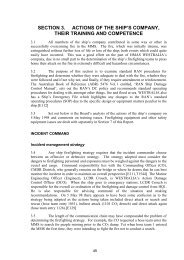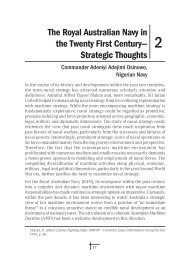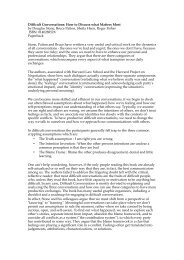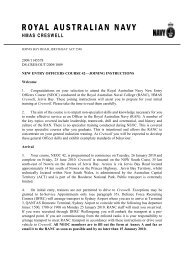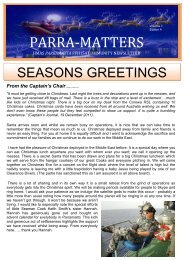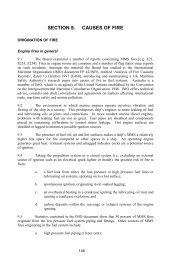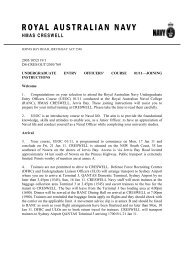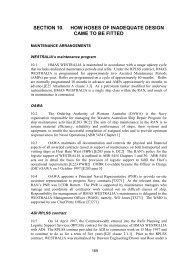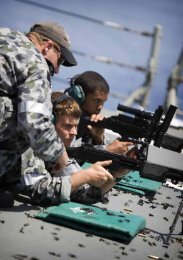UNDERSTANDING MARITIME DOCTRINE - Royal Australian Navy
UNDERSTANDING MARITIME DOCTRINE - Royal Australian Navy
UNDERSTANDING MARITIME DOCTRINE - Royal Australian Navy
Create successful ePaper yourself
Turn your PDF publications into a flip-book with our unique Google optimized e-Paper software.
Iraq War, 2003<br />
the leVels of maritime doctrine<br />
understanding maritime doctrine<br />
In the lead up to combat operations against Iraq in March 2003,<br />
<strong>Australian</strong> warships consistently operated in the difficult shallow waters<br />
off the Iraqi coast while enforcing a long running economic sanctions<br />
campaign on behalf of the United Nations. By maintaining a sustained<br />
overt presence close inshore they were better able to intercept<br />
smugglers, while at the same time building up a detailed picture of local<br />
civil and military activities. This experience proved of immense value<br />
when combat operations began, allowing for better understanding of<br />
changes in Iraqi activity and movement patterns, and more effective<br />
support for coalition forces operating ashore.<br />
<strong>Australian</strong> Defence Force (ADF) doctrine is a hierarchy of capstone<br />
doctrine, philosophical doctrine, application doctrine and procedural<br />
doctrine. Although these different levels of doctrine bear some relation<br />
to the levels of command – strategic, operational and tactical – the point<br />
at which one level is subsumed by another is rarely clear. That maritime<br />
warfare does not readily allow for clear distinctions between these levels<br />
of command further complicates the issue. Elements of procedural doctrine<br />
can have fundamental implications for every other level, just as changes<br />
in philosophical doctrine will have ramifications elsewhere.<br />
Application and Procedural Doctrine<br />
Application and procedural doctrine, which relate to the operational and<br />
tactical levels and the detailed mechanics of operations at sea, have a long<br />
professional history, starting with the RN’s Fighting Instructions of 1672.<br />
The RAN employed the modern British versions of Fighting Instructions<br />
as a primary doctrinal source for the operational and tactical levels of<br />
warfare until well into the 1970s. Other important sources of guidance<br />
for operations and tactics were found in a range of North Atlantic Treaty<br />
Organization (NATO), United States (US) <strong>Navy</strong> and allied publications to<br />
which Australia had access. In the case of operations with the US and New<br />
Zealand under ANZUS and with Singapore, Malaysia, New Zealand and the<br />
United Kingdom under the Five Power Defence Arrangements, considerable<br />
effort has gone into the development of mutually agreed procedures and<br />
tactics. Evolution of these procedures continues, constantly validated by<br />
regular multinational exercises, and providing the basis for coordinated<br />
multinational and combined operations in the event of contingencies.<br />
3



